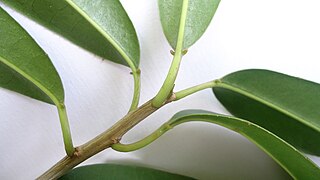
Sapium glandulosum is a species of tree in the family Euphorbiaceae. It is native to the Neotropics from Mexico and the Caribbean south to Argentina, and it has been cultivated elsewhere. It is the most common Sapium species. Its common names include gumtree, milktree, leche de olivo, and olivo macho.
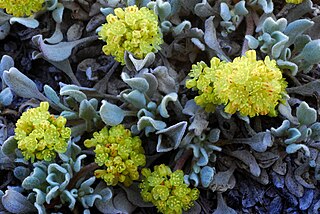
Eriogonum diclinum is a species of wild buckwheat known by the common name Jaynes Canyon buckwheat. It is native to the Klamath Mountains of northern California and southern Oregon, where it is an uncommon member of plant communities on serpentine soils. This is a small dioecious shrub forming low, thick mats rarely exceeding 20 centimeters in height. The curving, oval-shaped leaves are woolly and greenish gray in color, growing up to two centimeters long. The plant flowers in yellow to reddish rounded inflorescences, male plants producing clusters of staminate flowers, and female plants producing larger clusters of pistillate flowers.
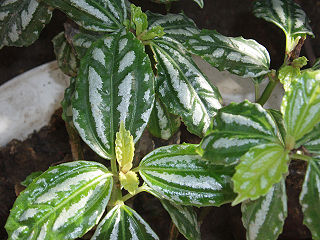
Pilea cadierei, the aluminium plant or watermelon pilea, is a species of flowering plant in the nettle family Urticaceae, native to China and Vietnam. The specific epithet cadierei refers to the 20th-century botanist R.P. Cadière. It has gained the Royal Horticultural Society's Award of Garden Merit.

Atriplex leucophylla is a species of saltbush known by the common names beach saltbush and white orache. It is native to the coastline of California and Baja California, and the Channel Islands, where it is a resident of beach dunes and other sandy areas.

Galium andrewsii is a species of flowering plant in the coffee family known by the common names phloxleaf bedstraw, Andrews' bedstraw, and needlemat galium.
Antennaria suffrutescens is a species of flowering plant in the family Asteraceae known by the common names evergreen pussytoes and evergreen everlasting. It is native to southwestern Oregon and far northeastern California. It grows in coniferous forests in the mountains, sometimes on serpentine soils.

Atriplex lentiformis is a species of saltbush.
Atriplex parryi is a species of saltbush known by the common name Parry's saltbush. It is native to the deserts and plateaus of eastern California and western Nevada.
Carex alma is a species of sedge known by the common name sturdy sedge. It is native to the southwestern United States and northern Mexico, where it grows in moist spots in a number of habitat types. This sedge forms a thick clump of thin stems up to 90 centimeters in length and long, thready leaves. The leaves have basal sheaths with conspicuous red coloration, often spotting. The inflorescence is a dense to open cluster of many spikelets occurring both at the ends of stems and at nodes. Each cluster is up to 15 centimeters long and 1 to 2 wide. The plant is sometimes dioecious, with an individual sedge bearing either male or female flowers. The female, pistillate flowers have white or white-edged bracts. The male, staminate flowers have visible anthers 2 millimeters long or longer. The fruit is coated in a sac called a perigynium which is gold to dark brown in color and has a characteristic bit of spongy tissue at the base.

Sagittaria sanfordii is an uncommon species of flowering plant in the water plantain family known by the common names valley arrowhead and Sanford's arrowhead. It is endemic to California, where it is known from a few scattered occurrences on the North Coast and in the Central Valley. Many occurrences previously noted in the Central Valley and in southern California have been extirpated as the plant's aquatic habitat has been lost to human activity.
Salix ligulifolia is a species of willow known by the common name strapleaf willow. It is native to the western United States. It grows in moist and wet habitat, such as riverbanks, swamps, and floodplains, such as in the Sierra Nevada in California.
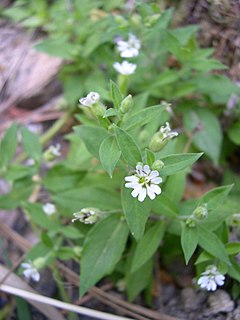
Silene menziesii is a species of flowering plant in the family Caryophyllaceae known by the common names Menzies' campion and Menzies' catchfly. It is native to western North America from Alaska through the western half of Canada to the southwestern United States. It can be found in many types of habitat and it is quite common in much of its range. It is variable in morphology and there are a number of varied subtaxa. In general, it is a perennial herb growing from a caudex, appearing matlike, decumbent, or erect, with stems a few centimeters to over half a meter long. It is usually hairy in texture, with upper parts bearing sticky glandular hairs. The leaves are lance-shaped, oppositely arranged in pairs, and a few centimeters in length, upper leaves usually smaller than lower. Flowers may occur in a cyme at the top of the stem, or in leaf axils, or both. Each is encapsulated in a hairy, veined calyx of fused sepals. The petals are white with two lobes at the tips. The plant is dioecious with male and female plants producing different flowers. The male and female flower types look the same externally; the stamens are reduced in female plants and the stigmas are reduced in the male.

Daphnopsis hellerana is a rare species of flowering plant in the genus Daphnopsis of the family Thymelaeaceae. It is endemic to Puerto Rico, where there were only four populations remaining in 1992, with a total of 125 individuals. It was federally listed as an endangered species of the United States in 1988.
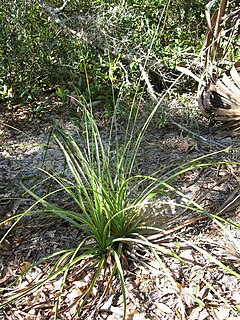
Nolina brittoniana is a rare species of flowering plant in the asparagus family known by the common name Britton's beargrass. It is endemic to Florida, where there are 72 known populations, only a few of which are large enough to be considered viable. It is federally listed as an endangered species of the United States.

Antennaria parvifolia is a North American species of flowering plant in the family Asteraceae known by the common names Nuttall's pussytoes and small-leaf pussytoes, it is native to North America.

Rhamnus davurica is a species of flowering plant in the buckthorn family known by the common name Dahurian buckthorn. It is native to China, Korea, Mongolia, eastern Siberia, and Japan. It is present in North America as an introduced species.
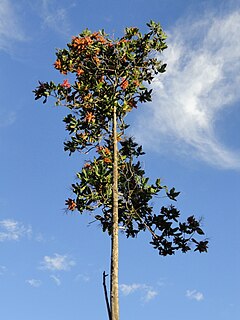
Triplaris americana is a species of flowering plant in the knotweed family known by many common names, including ant tree or pau-formiga, guacamayo, guayabo zancón, hormiguero, palo de Santa María, tachí, vara santa, pau-de-novato, formigueiro, taxizeiro, and devil tree. It is native to Central and South America, occurring from Panama to Brazil. It is also cultivated as an ornamental for its showy pink flowers.

Adenia globosa is a species of flowering plant in the passionflower family, Passifloraceae. It is native to tropical Africa, where it occurs in Ethiopia, Kenya, Somalia, and Tanzania. It is known as mpaga in Swahili.
Salix doii is a shrub from the genus of the willow (Salix) with mostly 3 to 4 centimeters long leaf blades. The natural range of the species is in Taiwan.
Salix ernestii is a species in the genus of willow (Salix) and grows as a shrub. The leaf blades are about 11 centimeters long. The natural range of the species is in China.













